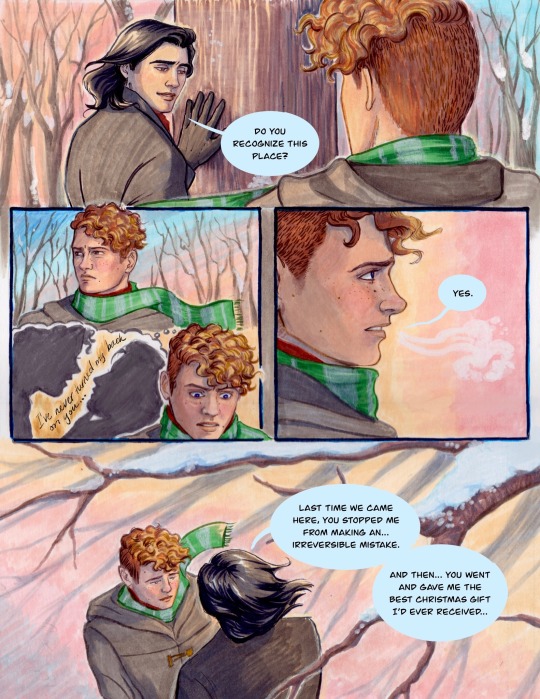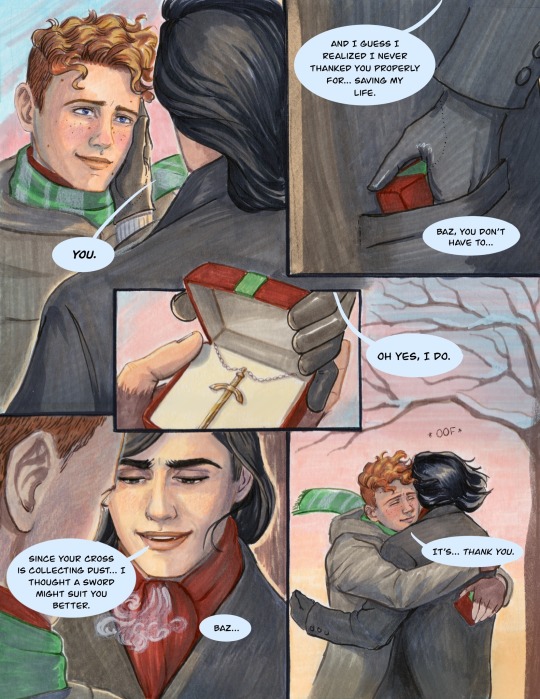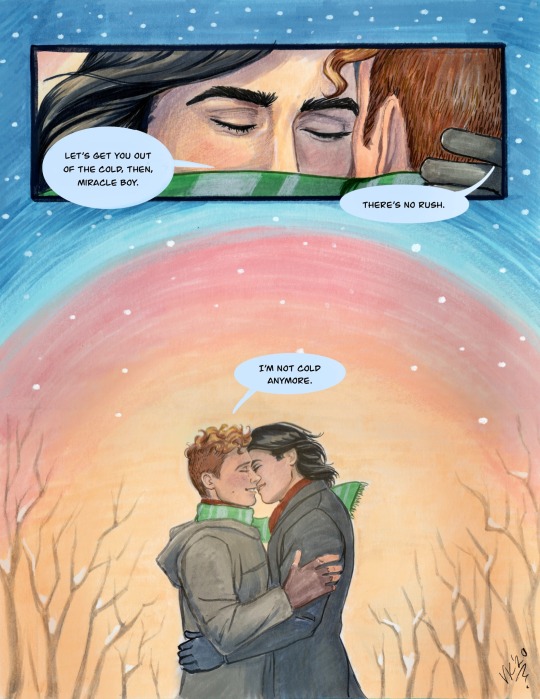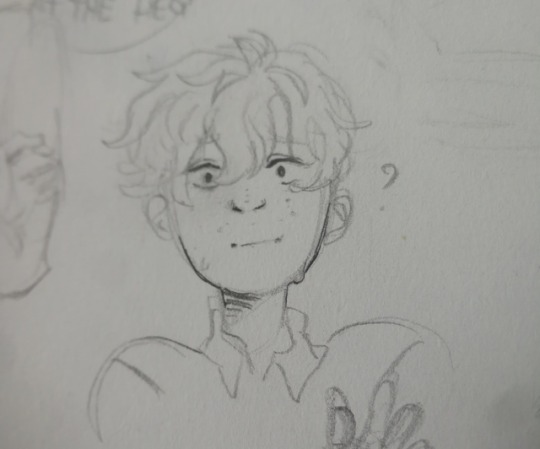Text

Posted this on Instagram but here’s the drawing I made for Baz and Rainbow Rowell’s birthday!! It was a little rushed but I hope you enjoy!!
(Also just a heads up: I switched accounts!! My old one was under the same username I’m trying to restart my account because uhhh 😳 so if y’all wanna see my art or writing please follow me here 😣🙏)
165 notes
·
View notes
Text
Because We Match - a Carry On CMV” is now finally on YouTube!!🥳 Just click the link down below!✨
And of course, happy birthday to our favorite vampire and the incredible @rainbowrowell !💕We hope our video does you justice.✨
Spoiler warning for the first book of the Simon Snow series, Carry On by Rainbow Rowell.
Trigger warning for fake blood‼️
The Baz Coffin scene was heavily inspired by an fanart of the wonderful @vkelleyart 💕
We really hope you’ll enjoy it!❤️
youtube
390 notes
·
View notes
Text




So pleased to finally present my contribution to the @let-it-snow-zine! This time, I decided to go out on a limb and render the whole comic in natural media. So for fellow art nerds interested in what I used to draw this, this is all Pitt Pens, Copic Markers, and Prismacolor Pencils on Bristol paper (with lettering done digitally). [EDIT: AND A WHITE ACRYLIC PAINT PEN FOR THE SNOW! 😅]
Hope y’all enjoy it, and be sure to read the rest of the zine for more holiday-themed heartwarming stories and art!
❄️❤️❄️
3K notes
·
View notes
Text






Presenting “Wedding Letters,” my contribution to the @goldendayszine! There’s actually an epilogue to this that I’ve been drawing, but it’s not quite finished yet. (Hoping to finish it in a day or so.)
Anyway, it’s INCREDIBLY fitting that the release day for all the zine content coincides with my 10th wedding anniversary (*blows kisses to Mr. VKelleyart*) because I drew a lot of the inspiration for this strip from my own wedding day and the path Mike and I took to the altar.
It’s a wilder story than you might expect, actually.
Because here’s the thing: My marriage was prophesied––twice––by my clairvoyant grandmother before she passed away.
Keep reading
4K notes
·
View notes
Note
Hi Maggie, I remember seeing a chapter of one of your novels with all the editing changes & notes somewhere. It might have been The Scorpio Races... It was really interesting to see how you do your line edits, so I was trying to find it again, but no luck. Is it still available or did I just imagine it?
Dear plumarin,
You didn’t imagine it. Not only did I do it, but I asked several writers I knew to demonstrate it as well, and those are all here:
part one
part two
part three
I’m sure I’d do it slightly differently now; that was ten years and a million words ago. There’s also more about how I edit demonstrated in ANATOMY OF CURIOSITY.
urs,
Stiefvater
562 notes
·
View notes
Text
Such super cute sketches!!! the expression on the faces!!!!
I’m like 90% sure (or more like hoping) that the first terrible impression was just because Baz was already gay panicking™



114 notes
·
View notes
Photo

Kintsugi - the act of embracing damage by repairing broken objects with gold.
4K notes
·
View notes
Text
Epics, Break-Up Songs, & That Old Chestnut, ‘Just Because You Don’t Like It Doesn’t Make It Bad’

Let’s talk narrative structure.
(this is gonna be long)
So, it’s April and the internet is all abuzz over new upcoming material from two big franchises: the new Star Wars trailer, and the new Avengers movie. My investment in both is simple, uncomplicated, a tourist’s interest, not a pilgrim’s. But I am very curious about them as a storyteller, because I think both use a narrative structure that’s going to dominate the next few decades. It’s gonna be one of those things when people say “remember all those movies and books from the naughts that did x and y?” and everyone who came of age in this time is going to nostalgically sigh and say ‘oh, man, they don’t make movies like that anymore’ and everyone who came of age a few decades before will hiss ‘thank GOD’ and the generation who came of age a few decades before them will say ‘I don’t know what you’re even talking about, they’re just movies.’
The thing about trends is that they will be just movies to people who are first really paying to media now. They will be normal, and whatever comes next will be the New Thing.
A Note About Trends And The Dominant Damn Paradigm
Trends happen when a particular subject, shape, or storytelling tic becomes so normalized in the mainstream that it becomes invisible to the average viewer or reader. They don’t see them as innovative, experimental, or even as stylization. It feels ‘real’ and so therefore communicates emotion and information straight to the consumer with the same efficacy as real life events. Some of these invisible trends are so evergreen that they seem permanent: Three act structure, training montages, prologues that take place in a completely different timeline. None of these are actually inherent to telling a story (there are all kinds of historical stories that don’t use them), but they’re so commonly used that they feel that way to most people. They’re just there. They’re just story.
Other things that are even less inherent can also be so normalized that viewers begin to not notice their use as unusual: a happy ending, having a good-looking guy as our narrator/ hero, having a woman die to begin the hero’s arc, blue/ orange filters, onscreen murder, characters breaking into song, a two hour run time, a 350 page count, etc., etc.
Narrative structure can trend as easily as anything else, and that’s what we’re looking at now. We’re moving from the age of break-up songs to the age of epics, a transition made weirder by the break-up songs still playing in the background.
Possibly when you read on you’ll immediately think of fourteen movies and books that don’t match the pattern I’m talking about. This is because Ppop culture doesn’t eat stuff that doesn’t fit in it — it just shades it with its huge, homogenous, trendy mass. There’s still stuff out there that is doing its own thing. Not everyone wore big shoulder pads and white pants in the ‘80s either, but we all know how we remember it.
Why Do I Care?
Because as a professional storyteller, it’s my job to know what is invisible (and thus costs the reader nothing) versus what is now outside the norm (and thus costs the reader something to process). I don’t mind asking the reader to work for things that are important to me, but I need to know when I’m doing it in order to make sure I can keep their overall load light enough that they don’t lose emotional investment and trade my novel for Netflix.
A Brief Pedagogical Interlude
I am often asked in my writing seminars to talk about how I handled point-of-view in the Raven Cycle, my four-book series that started in ‘12 and finished in ‘16 (although if that end date makes you sad, know that there’s a spin off trilogy beginning this fall). Folks often don’t even know what to call it. They call it third person. Third person close. Multiple third person. Omniscient.
Technically, it’s close third person broken occasionally by a few omniscient chapters used under certain conditions (for instance, on a group of psychics, on villains, on sentient forests).
Practically, here’s what it is: influenced by film.
I don’t think I meant for it to be. I think probably if you’d asked me at the time what I was doing, I would have said it was meant to be shaped like a dream. But practically, it is influenced by film, because I’d watched enough film for that structure to become my normal. Invisible.
And what do sprawling contemporary fantasy films look like? Multiple narrators with occasional villain cams and the snatch here and there of omniscient establishing shots of the setting or people who don’t carry a ton of the narrative but are tonally useful to eyeball for a second or two.
That is the Raven Cycle. It’s a structure that feels natural because we’ve seen it so often, but it’s actually a bit of a strange thing to translate it to written form. There’s a word for when a novel moves from protagonist to protagonist in short order, and it’s not a flattering one: head-hopping. It’s considered poor form, and for good reason. Readers only have so much emotional investment to spend, so the wisdom goes, and wouldn’t you rather they spent it all on your hero?
Or so the wisdom used to go.
The Break-Up Song Is Always In First Person
Do you guys remember Sleepless in Seattle? Garden State? House? For the longest time, pop culture was focused on the hero’s journey. There are books and books written on this subject but really all we need for purposes of this blog post is this: hero (1)(one)(I). One hero per customer, one hero per lane, one hero per story. The standard story followed one hero through a series of trials. In a happy story, he started out shit and became great. In a tragedy he started out great and went to shit. There were other characters, but they were supporting roles. The antagonist foiled our hero. The love interest acted as stake and prize and mirror. The comic relief let off some steam.
In novel form, this was even more pronounced, often focused through first person narration. You were sticking with this hero, dammit, to bitter end.
I remember a time in my twenties when we were up to our necks in the most intimate version of this. The shelves were chick lit, the screens were indie rock, the historical fiction followed one woman’s journey through one day of the plague in one small town in France as seen through her penned journal shared with no one.
We were living the prose version of the break-up song genre. Dude, it wasn’t like we were going to hear a verse from the point of view of the person who broke the singer’s heart. This wasn’t about them.
The Reaction to the Reaction
But writers are what they eat. Every writer writes stories that are responses to what they’ve taken in as consumers: a fond homage or an opposite reaction or a correction or a new angle.
And while the break-up song genre was happening, other films and books kept on being made. Thrillers and mysteries continued on even as pop culture had its moment with the intimate, character driven story of a single mother who died and haunted an olive oil decanter on a strange family’s shelf for a decade, and they began to rub off on each other.
Even as the trend of intimate stories passed, the character-driven nature of them left its mark. Readers and viewers no longer believed in the straightforward hero’s journey. No one was that simple. Batman got rebooted, James Bond got some consequences. Heroes got more and more morally gray. The world was getting more and more morally gray, too, after all, and narrative kept up. What was the price of privilege? What was the price of winning? Was this really a happy ending?
Narrative answered the question by glancing at the situation from other points of view, and those glances got longer and longer and longer. One POV became two. Became three. Became four.
Ok, Back To the Marvel and Star Wars Thing
Became Marvel and Star Wars. Now we’re fully into Trend: Epic. We humans have done this trend before, where everyone’s larger than life and the stakes are sky high and your backyard is full of giants and whatnot. But now this trend is being informed by coming on the heels of the break-up song. Readers and viewers developed a taste for deep character development in our emo phase and now want it at the same time that they now hunger for huge casts.
Previously, it’s a conundrum that would’ve been resolved by narrowing down the focus onto one person within that cast, digging down deep into their journey, and reducing everyone else to a secondary or tertiary character. Villain, love interest, comic relief.*
But that doesn’t satisfy the current trend of epic, of nuance, of a vast cast explored as deeply as possible. Viewers don’t want Poe to be simply a walk-on. They want villainous Loki to have as much of a character arc as heroic Thor. If a character is interesting, they want them handed a camera for as long as possible. And the more noble a hero seems, the more they want to see the skeletons in his closet, because no one believes in empty closets these days.
*interestingly, I just saw Venom last week, a film everyone had been telling me was “old-fashioned,” and what it gave me was precisely that old model.
You can see the difference in the way narrative point of view is handled if you compare the original Star Wars trilogy with the current. The two are close cousins, intentionally so, which makes for easy comparison. It doesn’t take long to see how the original trilogy focused quite tightly on the trio of Luke, Leia, and Han, and pretty tightly on Luke even within that, versus the new film, which follows the trend of spreading the character development as thick and deep as possible amongst a large cast who shares story as equitably as possible.
You can also track it in the length of commercial films. You need a ton of room to develop character, and you can watch block busters get longer and longer as they eek minutes here and there for a touching flashback or a crushing personal revelation or final hand clasp.
There’s a lot of pros to stories like this: there’s feels everywhere, as the internet says. We’re asked to engage emotionally with every storyline rather than intellectually. We’re given lots of characters to love. Empathy is pumped to all time high across the board.
But there’s cons too: if a character arc doesn’t get enough time (and they can’t all, because there are so many going), the emotional beats can feel unearned and forced. We might feel like we’re going through the motions, landing on beats that we know ought to be there, and beats that we want to be there, but feeling dissatisfied with how we got there.
It means that when it works, it works on an epic, massive, life shifting scale, everything snapping together with neat, agonizing emotion at the end.
It means that when it doesn’t work, we end up with empty spectacle that leaves us feeling disconnected and confused by why we didn’t love a thing that gave us everything we thought we wanted.
Oh God We’ve All Been Exposed!
I can feel it changing my narrative, too. At one point as I was working on Call Down the Hawk, the trilogy opener I mentioned up top, I realized that I’d spread my story too thin across characters. I was burning pages by the dozen as I tried to make sure they were all arcing in complicated, satisfying ways. When I shaved things down for pacing, I found myself with a skeletal, shallow plot outline. What the hell, I thought. You know better. Head-hopping is to be kept to a minimum.
But not in 2019. You are what you eat, and I’d been eating a lot of media that sat right smack in the middle of this epic narrative structure. I had to sit back and ask myself: what is the story you actually want to tell? Pick your cameras and trust them. And then I cut my important arcs to two and pushed everyone else back to secondary and tertiary.
Because here’s the thing: I don’t actually care for the multi-cam break-up song epic thing we’ve got going on right now. The world’s making a lot of movies that aren’t really for me these days. I’m not too fussed about it because I know the reaction to the reaction to the reaction that comes around on the other side will probably swing it back my way, but for now, I leave the cinema with a shrug more often than not, and I put down a lot of novels.
But here’s the other thing:
Just Because You Don’t Like a Thing Doesn’t Mean It’s Bad
Sometimes it just means it’s not for you.
At the beginning of all this I noted that the current story shape is going to feel like the default story shape to people coming of age now. Whatever was popular when you were coming of age is one of your default story shapes.
The key to being an interesting and dynamic human is making sure that you’re curious and flexible enough to be willing to accept other shapes. You don’t have to like everything, but if you don’t want to become obsolete, you gotta at least give it a shot. We all know the person who only listens to the music from their childhood, who says “they don’t write books like they used to.” Don’t be that person. Before you shake your stick at the kids on your lawn and say “that sucks” maybe ask if it’s just not for you.
And then wait a decade. ‘Cause it’ll come back around from the break up song to the epic to something totally different again and maybe to something that’s precisely your jam.
If not, no one’s stopping you from writing something that is.
ETA: Also probably worth noting that this narrative shift is probably inspired by fanfic and vice versa (since fanfic’s stakes are often purely emotional), but I can’t speak cohesively to that since I don’t read fanfic, I just HEAR a lot about it.
2K notes
·
View notes
Text
The way I see it Simon was going to sleep on the couch because he is scared of the wraith in his given guest room... I think they may have planned to spend the night apart, but Baz could just not keep away!
So, do you ever think about this

And then start to think about how they ended up lying on the floor and then on Baz’s couch

And then start to wonder why they didn’t just sleep together on Baz’s bed?
Because I have. And here’s what I think about it. So, the bed is probably like king sized, and it would have allowed them to spread out next to each other. BUT what if that wasn’t the point? What if they just wanted to be as close to each other as possible? The couch would be too small to lay beside each other, so they would have to sleep in each other’s arms.
I think this is exactly what happened. (Even if Baz did sleep “fitfully.”)
944 notes
·
View notes
Text

SIMON AND BAZ ARE BACK.
AND THEY’RE COMING TO AMERICA!
@entertainmentweekly has the full scoop! I am absolutely thrilled with this cover — designed by Olga Grlic and illustrated by @kevinwada
💛💛💛
8K notes
·
View notes
Photo
Wonderful, the art, the message, the whole thing!

Have you ever been so utterly moved by a piece of art that it drives you to create something of your own?
I got a sneak peek of some early line art by @vkelleyart, and spent half an hour crying in my car in a Costco parking lot while we discussed the beautiful symbolism of this magic-sharing moment in @rainbowrowell‘s Carry On.
Think about this: We all have moments when we are confronting something way bigger than us. There are also times when we play a supporting role to someone else’s battle. In both situations, we are strong and fighting our hardest—giving or receiving help doesn’t negate any of that strength.
I’m grateful for moments when I can be like Simon and give my strength to the people I love. And even more grateful for the support when I’m the flammable one trying to send back a dragon.
#rainbow rowell#carry on#Simon and Baz#simon snow#bazilton grimm pitch#sharing the magic#being there for others
124 notes
·
View notes
Photo

“The story is supposed to be over. Simon Snow did everything he was supposed to do. He beat the villain. He won the war. He even fell in love. Now comes the good part, right? Now comes the happily ever after…“So why can’t Simon Snow get off the couch? What he needs, according to his best friend, is a change of scenery. He just needs to see himself in a new light… That’s how Simon and Penny and Baz end up in a vintage convertible, tearing across the American West. They find trouble, of course. (Dragons, vampires, skunk-headed things with shotguns.) And they get lost. They get so lost, they start to wonder whether they ever knew where they were headed in the first place…”
2K notes
·
View notes







